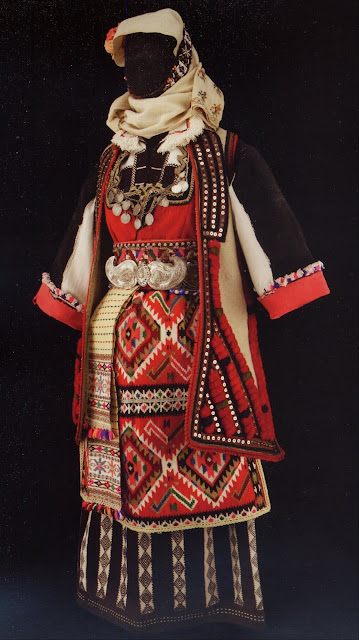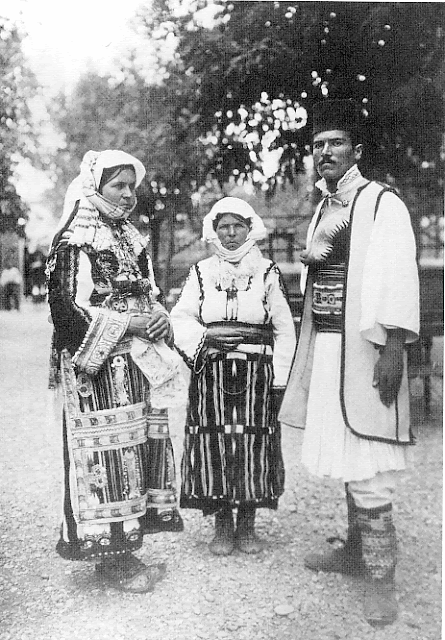Hello all,
Today I will do an article on the costume of Skopska Crna Gora. This is an upland area just outside of the city of Skopje, Macedonia, and is not to be confused with the nation of Montenegro. [Crna Gora means Black Mountain, and obviously there is more than one black mountain.] This is found just to the north of the region of Skopska Blatija, about which I have already written a couple of articles. Above you can see on the left a married couple, and on the right a single couple.
Here are a couple of maps to help you orient yourselves.
The most striking difference between this costume and that of Skopska Blatija is the embroidery on the chemise. This is done in mostly black wool, and the result is a three dimensional design based mostly on texture. This requires bright light to appreciate, and is difficult to photograph. Here are a couple of married women's chemises, which have the more extensive embroidery. As you can seem the embroidery mostly follows the seams.
This type of textured embroidery is also found in parts of Romania, Moldova and Ukraine, as well as elsewhere.
Here are some close-up views of the embroidery.
Here is the cut of the woman's chemise
http://www.britishmuseum.org/research/collection_online/collection_object_details/collection_image_gallery.aspx?assetId=399951&objectId=1537197&partId=1#more-views
This type of embroidery is greatly admired in the larger region. Brides of the neighboring Skopska Blatija region would often wear a 'crnogorka', that is, a chemise with embroidery in the style of Skopska Crna Gora for their wedding, rather than one embroidered in their own style, although the rest of the outfit remained the same. The arrangement of the embroidery is not quite the same though,.
This is such a chemise from the collection of The British Museum.
The apron used in this region is similar in construction to that of Skopska Blatija, but is limited to a single color with some striping, rather than the large tapestry designs. a sash, belt and vest are also worn.
The vest, dolama, is covered with silk tassels along the front and on the lower back. It is worn over the sash and apron.
Here is the cut of the dolama.
Knitted patterned socks and opanci [moccasins] are also worn with this costume.
The chemise for a single girl has significantly less embroidery.
The cut is extremely similar.
The apron is shorter, and the vest, called zbun, has more silk fringe and a somewhat different cut.
The dressing of the hair is simpler.
The men's costume is almost the same as in Skopska Blatija, with two exceptions. The vest is somewhat different.
And a second, longer vest, the dzhube is worn over the first. This garment was also formerly worn in Skopska Blatija.
Thank you for reading. I hope that you have found this interesting. I will close with a few more photos of this costume.
Feel
free to contact me with requests for research. I hope to eventually
cover all of Europe and the Former Russian Empire/Soviet Union. I also
gratefully accept tips on source materials which i may not have. I also
accept commissions to research/design, sew, and/or embroider costumes
or other items for groups or individuals. I also choreograph and teach
folk dance.
Roman K.
Anica Petrusheva, 'Narodna Noshnja u Skopskoj Crnoj Gori', Zagreb, 1988
Angelina Krsteva, 'Narodna Nosija od Skopska Blatija', Skopje, 1998
Kamelia Gruncharova, 'Tradicionno Narodno Obleklo po Porechieto na Reka Struma', Sofia, 2006
Angelina Krsteva, 'Macedonian Folk Embroidery', Skopje, 1975
Anica Petrusheva, 'Narodna Nosnja u Skopskoj Crnoj Gori', Zagreb, 1988
Georgi Zdravev, 'Macedonian Folk Costumes I', Skopje, 1996
Georgi Zdravev, 'Macedonian Folk Costumes - Weavings, Embroideries, Knitting, Adornments and Jewelry', Skopje, 2005
Bobbie Sumberg editor, 'Young Brides, Old Treasures', Seattle, 2012
Nikola Pantelic, 'Traditional Arts and Crafts in Yugoslavia', Belgrade, 1984
Vera Klichkova, 'The National Dresses [sic] of Macedonia', Skopje, 1963




















































Wonderful resource, thank you!
ReplyDeleteI really appreciate the patterns and the explanations/ descriptions.
Hello I'm Italian and I'm fond of ethnology.
ReplyDeleteSince I've learned about your blog I've became an habitual follower.
I think your articles are interesting, complete and fine written.
I'm looking foward to the next one.
Greetings from Italy
I have just finished reading a great work called Resplendent Dress from Southeastern Europe A History in Layers Fowler Museum Textile Series UCLA which I think you would enjoy. thanks for your terrific blog.
ReplyDelete@śmierć matki
ReplyDeleteNot necessarily. Slavs had a strong belief that women were tied to magic a lot more than men, by nature. And, so I've heard, it was believed that magic hailed from her hair. A lot of customs had certain days forbid women to wash their hair or let their hair loose. It makes sense that Slavic women covered their hair, and this is just my guess, but to ward off demons or bad magic? Anyways, it's the covering of the hair, not the face that is important, and hence it has nothing to do with patriarchy, but rather with belief in the occult.
Read the description of a kolo dance in this region, and of the women's costume and demeanor, by Rebecca West in Black Lamb, Grey Falcon (1941), pp. 672-680.
ReplyDelete